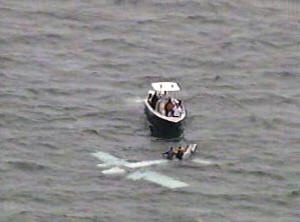|
|||||||||||
|
|
|
|||
|
By Jim Douglas |
||||
 |
August 23, 2010 -
Crewmembers from the U.S. Coast Guard, Bahamian Air Sea Rescue
Association (BASRA) and Royal Bahamian Defense Force (RBDF) respond to a
downed Piper aircraft in the waters about 23 miles northeast of
Freeport, Bahamas today. All six persons aboard the aircraft were
located with no injuries
Operation
Reports to the
Coast Guard indicated the aircraft was going down due to engine trouble
and the passengers were requesting assistance. The pilot had passed
their tail call numbers before losing communication with the tower. |
|||
|
|
||||
|
The Piper Aztec
PA-23-250, with tail numner N20373 is a fixed wing multi-engine aircraft
is owned by Cambridge Air Inc Wilmington, Delaware. A Coast Guard Air
Station Clearwater, Fla., C-130 aircrew launched and assisted in the
search for the down aircraft. At approximately 12:30 p.m. RBDF smallboat
crews located the downed aircraft with six persons aboard. All six
survivors were transferred and it was later confirmed that all persons
were accounted for with no reported injuries.
|
||||


